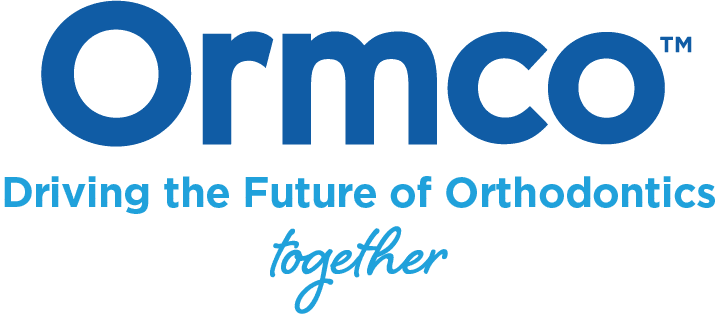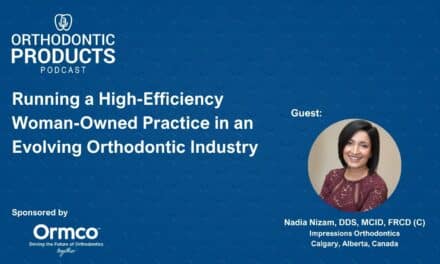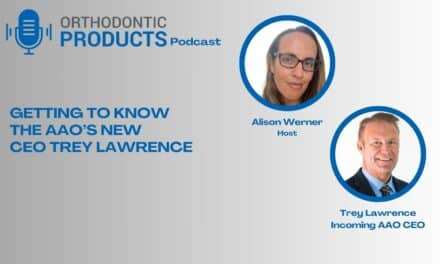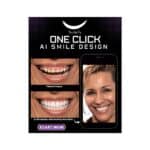Clear aligner therapy has reshaped how orthodontists approach treatment planning, patient experience, and clinical efficiency. In this episode of the Orthodontic Products Podcast, sponsored by Ormco, host Alison Werner talks with Ricky Caples, DDS, MS, of Caples and Robinson Orthodontics in Monroe, Louisiana, about how aligners fit into his multi-location practice and why he chose to make the switch to Spark Aligners. With more than three decades in orthodontics, Caples has seen the specialty evolve from traditional twin brackets to digital workflows that allow for more predictable outcomes and a smoother patient journey.
Over the course of the conversation, Caples shares how his experience with Spark Aligners has changed the way his team approaches treatment—from fewer refinements to improved patient comfort. He also discusses how Ormco’s support and ongoing software updates have made the transition to Spark seamless, and how combining the Spark Aligner system with the Damon Ultima bracket system has simplified operations across his five offices. For Caples, the integration of aligners and brackets under one company not only improves communication and case management but also enhances the overall quality of care.
What You Will Learn From This Episode:
-
How Caples integrated Spark Aligners into a large, multi-office orthodontic practice
-
What sets Spark apart in terms of comfort, predictability, and patient satisfaction
-
How Ormco’s support structure helps streamline onboarding and case troubleshooting
-
Why combining Spark Aligners and the Damon Ultima system simplifies treatment workflows
-
Caples’ advice for orthodontists hesitant to adopt new aligner technology
Chapters
00:00 Introduction to Dr. Ricky Caples and His Practice
02:57 Evolution of Orthodontics: Clear Aligners and Digital Tools
06:00 The Spark Aligner Experience: Workflow and Patient Comfort
09:02 Complex Cases and Versatility of Spark Aligners
11:58 Comparing Spark Aligners with Competitors
15:11 The Ultima Bracket System: A Game Changer
17:54 Embracing Change in Orthodontics
Guest Bio:
Ricky Caples, DDS, MS, has been a practicing orthodontist in Monroe, La, since 1993. He received his DDS degree and his MS in orthodontics from Louisiana State University. He is a Diplomate of the American Board of Orthodontics and an active member of the American Association of Orthodontics, the Southwestern Association of Orthodontics, and the past president of the Louisiana Association of Orthodontics. He is also a member of the American Dental Association and received the Distinguished Service Award from the Louisiana Dental Association. He is also a member of the Cleft Palate Team of Northeast Louisiana. Caples is a collector of vintage convertible cars and rare watches. He spends his spare time with his wife Lynna, traveling or enjoying his family of two children and 4 grandsons. He is an avid turkey hunter.
Podcast Transcript
Alison Werner (00:00)
Hello and welcome to the Orthodontic Products Podcast. I’m your host, Alison Werner.
In this episode sponsored by Ormco, I talk with Dr. Ricky Caples of Caples and Robinson Orthodontics located in Monroe, Louisiana. With more than three decades in practice, Dr. Caples has seen the orthodontic specialty evolve from traditional twin brackets to the digital aligner driven workflows shaping the industry today. He shares how clear aligners fit into his practice, why he made the move to Spark clear aligners, and what that’s meant for treatment efficiency in the patient experience. We also discuss his long time experience with the Ultima bracket system.
and now having both solutions under ORMCO’s umbrella has streamlined care and support for his team and patients. Here’s our conversation.
Alison Werner (00:44)
Well, Dr. Caples, thank you so much for joining me. Really great to talk to you today.
Ricky Caples (00:49)
It’s an honor to be here. Thank you for having me.
Alison Werner (00:51)
Yeah, so to get started, can you tell our listeners about yourself and your practice, where it’s located, your team, the type of patients you typically see?
Ricky Caples (01:00)
You bet. So I’m in Monroe, Louisiana. I came here in 1993. I bought a practice from Dr. John Parker. I actually had five of the girls from 1993. They’re just starting to retire. So I’ve been so lucky and blessed with the great staff. 26 ladies. I’ve got Dr. Chris Robinson that came into the practice in 2001. Amazing partner. And then recently Dr. Cammie Laird joined the practice about two years ago. She’s been a great asset.
coming on board. Also, we’re a five office practice. Main office is in Monroe. We have three or four satellites that we go to and we do work four days a week, most weeks. Patient base is amazing. Most of our referrals are probably from the practice. We, of course, we do have doctor referrals, but we have such a family
oriented practice that the patients are more than just patients, they’re friends, family and they treat us that way and we treat them that way. It’s a great symbiotic mutualism if you will.
Alison Werner (02:09)
Oh, great. Well, given the fact that you’ve been in practice for a while, how have you seen the industry and treatment options evolve from when you started to now, especially when it comes to clear aligners and even digital tools?
Ricky Caples (02:22)
So clear aligners have revolutionized orthodontics. course, know, years ago we had a ⁓ twin bracket and they’re clear aligners. was lucky I trained at LSU School of Dentistry, an unbelievable orthodontic department. And Dr. Jack Sheridan was the first, one of the pioneers on working with clear aligners. ⁓ He invented the Essix retainer, which almost any orthodontic knows, and they spell it E-S-S-I-X.
but it really is S to the sixth power, stands for Sheridan Superior Stability for the Social Six. Very few people know that, but that’s where the term Essix came from, or Essix material. So we were using, even in our residency, we were doing some stuff with aligners, very primitive. We didn’t have near the technology that we had today. So as an orthodontist, we were pretty much,
Alison Werner (02:57)
⁓ Okay.
Mm-hmm.
Ricky Caples (03:16)
⁓ you had to get on the aligner bandwagon at some point. We all know that there was one aligner company that they spent like $160 million on advertising and they became synonymous with clear aligners and it was a good product. That’s about all we all had to use. As it evolved, even the mail order aligners came along. The purple boxes that people come carrying in my office, they go, bought this but it doesn’t work. What should I do?
Alison Werner (03:28)
Mm-hmm.
Mm-hmm.
Good.
Ricky Caples (03:45)
And my response was, would you have scissors at home? And they go, yeah, I’ve got scissors. I go, do you cut your own hair? They go, no. I said, well, you shouldn’t straighten your own teeth either. So along comes Spark. Spark comes along, I’m going to say 20, 21, the pandemic was going on. What did it bring to the table? A more clear aligner, a more comfortable aligner. And the main thing was a much more predictable result. What you saw on your
ClinChecks and your approval was what you would see happening in the patient’s mouth. could literally go to that aligner, look in the mouth and go, this is working, which was a beautiful thing. You didn’t have that before. The support with Spark is unmatched. ⁓ Ormco has done such a great job of putting together CE so that when you come on board,
Alison Werner (04:28)
Okay.
Ricky Caples (04:42)
you’re not floating around out there trying to figure out things for yourself. They’ve got the MasterCOIP meeting they bring in ⁓ Ivan and Diego from over in Spain. I had to stop and think. And the MasterCOIP meeting I’ve attended at least three times because you always leave with more information and with some pearls that you didn’t have before you went to those meetings. ⁓ The support in your hometown.
Alison Werner (04:45)
Mm.
Yeah
Ricky Caples (05:12)
Kim Brumel is our rep with Ormco. She’s amazing. If we have a question she doesn’t have the answer to, she’s gonna have you that answer probably within 30 minutes. She’s gonna have somebody that can help you. ⁓ She, Sheridan works with her. They’re so good at getting us what we need when we need it if we have a problem. Let’s fast forward to using it with the patients, the aligners. I’ve had patients that have had both
competitor aligners and both Spark they’ll tell you there’s no comparison it’s so much more comfortable and I would say that the number of refinements that we have to do certainly has gone down which means less chair time time is the commodity now people just don’t have enough time they don’t really they love you but they don’t want to spend a lot of time in your office they like to be given their Spark aligners and they’ll go do their thing it works great let me just
Alison Werner (05:46)
Mm.
Yeah.
Right.
Yeah,
Ricky Caples (06:11)
⁓ It’s an unbelievable system.
Alison Werner (06:12)
yeah, yeah. Well, so talk to me about how many cases do you think you’ve completed with Spark at this point?
Ricky Caples (06:19)
who that, you know, I’ve tried to put a number that well over a thousand one and, and that’s my partner and I, we share patients. it’s not like there’s a Dr. Robinson patient or Dr. Caples patient. So we share patients and we get to see different things that we each do when we do set up our approval. And so we’ve, we’ve treated a lot of cases.
Alison Werner (06:24)
Okay. Okay.
Yeah. Yeah.
Ricky Caples (06:45)
we’re treating more and more. There was a time where you would have a day with 80 patients on the schedule. If you had three aligner cases, go, oh, I got three aligner. That’s a lot. Now I would say 50 % probably of our day is aligner patients. I actually worked this morning and I would say that probably I saw 46 people earlier today. Of those 20 were aligner cases.
Alison Werner (06:49)
Mm-hmm.
Yeah.
Okay.
Okay, so then the workflow for you is is good.
Ricky Caples (07:17)
It’s wonderful
and the fact that, so what really can go wrong with the aligners There’s not a lot. The variable we have is the human element. ⁓ I tell people you have to wear these things 22, 23 hours a day. It’s like braces, but you have the luxury of taking them off to eat real fast and brush real fast and put them back in. They only work when they’re in place. I tell people, look, it’s like dieting. I know when I wake up in the morning, this is what I’m supposed to eat.
Alison Werner (07:22)
Mm-hmm. Yeah.
Mm-hmm. Yeah. Yeah.
Ricky Caples (07:45)
I get home at night and go, that’s not what I ate. I didn’t do good today on my diet. It’s the same thing with the aligners You know you’re supposed to wear them 23 hours a day. If they get 20 hours a day in, you know what? It’s still going to work out just fine. They may have to wear an aligner a little bit longer, but if you educate them, the public is so smart these days as far as what’s going on with what they’re doing, that you don’t have to babysit them very much. They get it.
Alison Werner (07:49)
Yeah.
Mm-hmm.
Mm.
Ricky Caples (08:13)
They know what they’re supposed to do and they also will be honest with you and say, you know what? I went on vacation, I was a little bit lax, so I wore this last tray a little longer. You know what? You pat them on the back and say you did the exact perfect thing. So it’s almost foolproof.
Alison Werner (08:22)
Hmm.
I’m curious, is there any complicated cases that you’ve treated with Spark aligners that kind of stand out to you and kind of told you, okay, this is this is the right system for our practice?
Ricky Caples (08:41)
So when you first get started, you say, okay, I’m gonna treat an easy case, a little crowding or something like that. Then you get, when you go to the MasterCOIP and you see what can be done with the aligners then you say, okay, I’m gonna color outside the lines a little bit. So I’ve treated open bite cases with TADs and rubber bands over the aligners to intrude the posterior occlusion to close the bite I’ve treated…
Alison Werner (08:45)
Mm-hmm.
Ricky Caples (09:07)
cases for protraction where you were trying to burn anchorage and move teeth back, you put in some tads, you can still do it with the aligners Rubber bands with the aligners Just like with braces, you can have rubber bands to help fix your class 1, class 2, class 3s. so the more you learn, the more versatile the product becomes for you and you realize that you can do anything with the aligners that you could do with braces. You just have to take time to get the knowledge.
That was always my goal. I wanted to be able to look at a patient and say, did I treat them with braces or did I treat them with aligners and not be able to tell the difference? And when that, and you know what? I can do that with Spark. I can’t say I ever do that with the competitor.
Alison Werner (09:37)
Hmm.
Okay.
Really?
Okay, okay. Well, with so many aligner brands available, what makes Spark stand out for you compared to the other ones you’ve worked with as you’re, and especially as you were making your decision to switch?
Ricky Caples (10:05)
Well, and so One the support Because you’re gonna have questions you’re you’re you’re doing it’s a new product You’re gonna have questions the support was always a hundred percent. It was not like that With the others that we use their support was very sketchy ⁓ Kim is our rep she’s in our office at least once every two weeks and I can say That was certainly not the case
Alison Werner (10:13)
Yeah.
Yeah.
Ricky Caples (10:31)
with the competitor. As a matter of fact, I’m not sure the last time we saw the rep. just, so support is the answer, one of the answers. Two, the comfort and patient acceptance. They put the aligners in and they go, this is so comfortable. This is so clear. And they’ll come back and go, my friends didn’t even know I had anything in my mouth. And they’re happy about that. And then again, the results, that’s what we’re after.
Alison Werner (10:35)
Okay. Yeah.
Mm-hmm.
Okay.
Yeah.
Ricky Caples (11:01)
a board
quality result on every case we treat. Does it happen? No. Any orthodontist that’s done this long enough will tell you that you don’t get a board quality, but it’s usually not a failure of the product and it’s not a failure of the doctor, patients are patients, people are people, and sometimes they just don’t do exactly what you ask them to do. But so as far as the support and the result of the treatment after you get finished,
Alison Werner (11:03)
Mm-hmm.
Yeah. ⁓
Ricky Caples (11:31)
and the comfort of the patient throughout treatment are the three big selling points for us that made Spark our choice.
Alison Werner (11:34)
Mm-hmm.
Yeah.
Yeah. For you as the clinician and also for your staff, what about the Spark approver software? How has that experience been?
Ricky Caples (11:47)
It’s been great and they update it quite often. They’re constantly making it better and better. And you you have to spend a little time to catch up on the technology because they bring you these wonderful things and you have to sit down and go, I didn’t know that was available. And again, that comes back to the support because they will come in and say, you know what, we’re going to spend 10 minutes and we’re going to show you this new addition to the software that is so much easier than it was before.
and again when you set the teeth, used to we would have to over correct the rotation or we would have to do a little extra try to get it squeeze it out of the product not with Spark. Once you set it and you look at it and you go I like what I’m looking at you hit accept they send you the aligners and when you get finished with whatever aligners say they have 36 aligners you get finished with that what you see is exactly what you had on the screen 36 aligners ago when you started.
Alison Werner (12:26)
you
Mm-hmm.
Yeah.
Yeah. I know that Ormco has rolled out new updates to the Spark Approver software and kind of the Spark platform overall with the aligner. Is there anything that stands out to you in like the last year or so since you onboarded Spark aligners that has stood out to you of like, yeah, I really needed this addition. Like this is, this helps me.
Ricky Caples (13:07)
You know, it took a while to kind of learn even all the stuff that they came with at first, how you could click stuff on, click stuff off. You could remove the attachments, you could put the attachments back on. You know, they have a grid on the screen that you can actually measure everything and see how much expansion you’re getting. so to say that I know everything that you can do with that approval program is not true, but I do know that I have everything at my…
Alison Werner (13:12)
Mm.
Yeah.
Hehehehe. Hehehehe.
Ricky Caples (13:35)
disposal that I need to treat the cases like I want to treat them. when they do put out new software, they’re very good about coming out and educating.
Alison Werner (13:43)
Okay. Well, I know that you know, Spark is part one part of Ormco’s product portfolio. And I know you also use the company’s Ultima bracket system in your practice. How long have you been using Ultima and how many cases have you completed there? Do you think? ⁓
Ricky Caples (13:57)
Oh, tens of thousands of those.
So back when Dr. Chris came into practice around 2001, self-ligating was coming on. So a twin bracket is the same thing as the rotary phone that your grandmother had. You you picked it up, had to tie it in. So the Damon Ultima is an iPhone 17. And you you’ve got the world in your palm and you just have to know how to use it. Our journey with that began, we were a beta test site for
Alison Werner (14:11)
Yeah.
Mm-hmm.
Ricky Caples (14:27)
another major manufacturer and we tried it and we were trying Damon at the same time. The other manufacturer brought me in and said, Ricky, what do you think? What do you think about our product? And I said, start over. And they said, what? I said, yes, you need to start over. This product is not going to do well. It’s hard to get the wires in the brackets. I’ve got patients in the chair that are very uncomfortable. And they have eventually, I think,
abandoned that product. But anyway, we chose Damon. We went with Damon. I can’t tell you enough good things about it We’re on the Ultima now. We’ve gone through probably at least two or three upgrades and I would be a miss if I didn’t give a shout out to Dr. Dwight Damon. He’s he’s eight feet tall He’s 50 % heart and 50 % brain and he’s if you go to the Damon Forum, yes, so you get to see you get to see Dwight Damon
Alison Werner (15:00)
Yeah.
Yeah
Right.
Ricky Caples (15:26)
He’s
I have no idea how old he is, but he’s still in it and he’s changed the life and made orthodontics so much better for not only the practitioners, but mainly the patients. So you can imagine from a wire being pushed into a bracket and tied in and extreme discomfort to opening a door, putting the wire in, shutting the door. We’re going to see you in eight weeks, 10 weeks, not every four weeks. Mom’s not having to take off work. You’re not missing school.
your patient flow is better and so the the Damon system the best in the world. Now let’s fast forward to Ultima what makes it different. So most bracket slots were always a square and Dwight had his aha moment and started working with a parallelogram and it you don’t really get it until they have these guys that are like brainiacs that come to the meeting but they actually
Alison Werner (16:04)
Yeah.
Ricky Caples (16:24)
have this all in blocks and show you how it works. And when you look at it, you go, that makes so much sense. And it’s exactly what you see in your clinic also. So when you’re in there working with your patients, we shoot for, we grade ourselves. We look at our result and go, okay, are the roots parallel? What about the marginal ridge height, rotations, smile, check everything. With the Damon Ultima system, you don’t have to work overtime to get a board quality result every time.
Alison Werner (16:55)
Okay. So having that experience with the Ultima system, Damon system, Ultima system being that long of a Ormco product user, what does it mean to you to have both your aligners and your bracket system from the same company? Kind of that one stop shop.
Ricky Caples (17:15)
It is the best of both worlds. It’s wonderful in the fact that we get the same support on our bracket systems as we get on our aligner systems. And again, you’d have to see what we had to with before, before you would respect and appreciate what we have now. But it couldn’t be better. It’s so much nicer working with one company and you know,
Literally, if I picked up the phone today, Kim would say, I’m going to call Joe or I’m going to call Alex. I’m going to call somebody and I’m going get you an answer. Guess what? By four o’clock in the afternoon, you have an answer to whatever you’re trying to deal with. So the support is great. Turnaround time. Great. The fit of the aligners. Great. So all the things that you have to worry about, you don’t have to worry about anymore. They’re there for you.
Any support questions you have will be answered very quickly.
Alison Werner (18:15)
So before we wrap, for orthodontists who might feel hesitant about change, what would you tell them about the value of kind of staying open to new tools and approaches as the specialty evolves?
Ricky Caples (18:32)
So Cammie is our youngest partner. She’s been out about four years and they actually got to do some aligner stuff while they were in their residency, which we did not. It was such an primative stage. But I would tell anyone that was hesitant to try Spark Aligners to visit with their rep, call me. You’re welcome in my office if you like. And there’s so many guys across the United States that are amazing with Spark Aligners that will share the story.
Alison Werner (18:43)
Okay. Right.
Ricky Caples (19:01)
Because when you have something that works that good, it’s almost like the gospel. You need to get it out there. You need to tell and share it.
Alison Werner (19:09)
Yeah. Well, Dr. Caples, thank you so much for taking the time to talk to me about your experience. I really appreciate it.
Ricky Caples (19:15)
Well, and Alison thank you for your time.
Sponsored by














